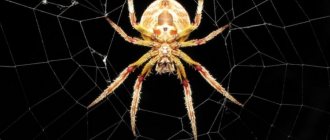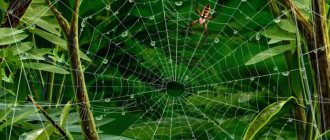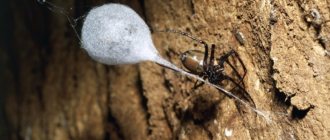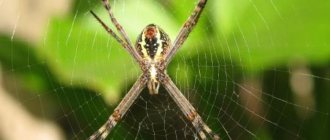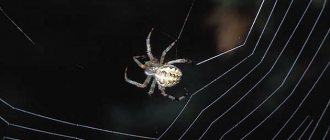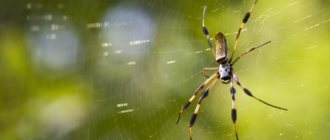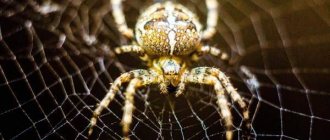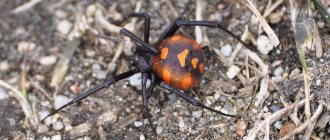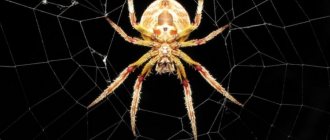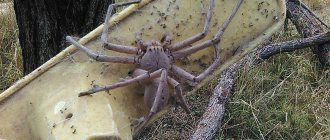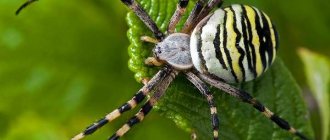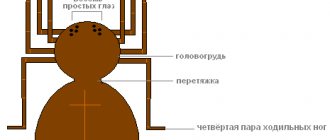Surely each of you has paid attention to the sophisticated, delicate, silky “handkerchiefs” that spiders hang on trees and grass in the sunny summer. When silvery dewdrops glisten on openwork spider yarn, you will agree that the sight is incredibly beautiful and bewitching. But several questions arise: “where is the web formed and how is it used by the spider”, “where does it come from and what does it consist of”. Today we will try to figure out why this animal decorates everything around with its “embroidery.”
Stopped for an hour
Many scientists devoted not only entire treatises and hours, but also years of their lives to spiders and their webs. As Andre Tilkin, a famous philosopher from France, said, weaving a web is an amazing performance that you can watch for hours and hours. He wrote more than five hundred pages of a treatise on the web.
The German scientist G. Peters argued that, watching spiders for hours, you don’t even notice how time flies. Even before Tilkin, he told the world about who these amazing creatures are, how a spider weaves its web, why it needs it.
Surely, more than once, when you saw a little spider on a leaf doing its painstaking work, you stopped and watched. But we always don’t have enough time for beautiful little things, we’re always in a hurry, so we can’t stop, linger a little longer. If this was the time, each of us could probably answer the question: “How does a web appear, why does the spider not stick to its web?”
Let's stop for a moment and figure it out. After all, the question is really interesting, and the process is fascinating.
Competition “Bio/Mol/Text”-2020/2021
This work was published in the “School” category of the “Bio/Mol/Text” competition - 2020/2021.
The partners of the nomination are the Vita Medical and Biological School and the New School.
The general partner of the competition is the annual biotechnology conference BiotechClub, organized by the international innovative biotechnology company BIOCAD.
The sponsor of the competition is SkyGen: a leading distributor of life science products on the Russian market.
Competition sponsor: the largest supplier of equipment, reagents and consumables for biological research and production.
They caught three hairy spiders in the bushes and... made them work. One spider was weaving a net for fishing from its web. The second spider wove clothes from its web. N. Sladkov. Planet of Wonders
In the last century, humanity has experienced more than one technological revolution. These revolutions changed our lives. Inventions such as cars, airplanes, televisions, lasers, computers and the Internet have accustomed us to change. History has shown that we cannot stand still. Technogenic revolutions have also affected the production of new materials for various spheres of our life. From heavy machinery and hard metals, humanity is moving towards biotechnology and biomaterials. One of these promising materials is spider web - an amazing material that combines the strength of steel, the rigidity of Kevlar and lightness. cobwebs. It also turned out that spider webs can be effectively used in various medical bioconstructions, since spider web material is biologically compatible with the human body [1].
Biomolecule previously spoke about some of the properties of “spider web glue” and the possibilities of its use: ““Smart glue” from spider webs” [3].
But for the industrial use of any material, it is important to solve at least two problems: how to obtain the material in sufficient quantity and how much it will cost. Silkworm silk has had no competitor in the form of artificial or synthetic material for 4,500 years. In our age of technical revolutions, spider silk, having not yet found widespread use in its native form, already has serious synthetic rivals. Will he even be able to withstand such competition?
In this article, we'll look at how humans have tried to adapt spiders to life in captivity over the centuries, and try to understand whether spiders can be tamed and made to work for us.
Where does it come from?
Spiders are the oldest creatures, living on earth for more than two hundred million years. Without their web, they, perhaps, would not be so interesting to humanity. So where do spiders’ webs come from and what does it look like?
The web is the contents of special glands that many arthropods have (false scorpions, spiders, spider mites, etc.). The liquid contents can be stretched without tearing. The resulting thin threads harden very quickly in air.
Each spider has several specific glands on its body that are responsible for producing webs. Different glands form webs of different types and densities. They are located on the abdomen in the form of very thin ducts and are called “spider warts”. It is from these holes that a liquid secretion is released, which soon turns into a beautiful web.
With the help of its paws, the spider distributes and “hangs” the web where it needs it. The spider's front legs are the longest, and they play the main role. And with the help of its hind legs, it grabs drops of liquid and stretches them to the required length.
Web adaptations associated with reproduction and dispersal
As already noted, webs are used by spiders during their breeding season. It is thanks to the web that this process has become unique in its complexity and originality among similar phenomena characteristic of arthropods. Spiders are characterized by internal fertilization, which is preceded by mating. But the copulatory organs of males (bulbs) are not located on the abdomen, but on the forelimbs - pedipalps or claws (not to be confused with four pairs of walking legs). To transfer sperm from the underside of the abdomen, where the male genital opening is located, to the spermophore of the bulbs, a so-called sperm mesh is used. Often this is a small delicate mesh of a triangular or quadrangular shape, stretched horizontally in the form of a hammock. Pressing his abdomen against the mesh, the male leaves a drop of seminal fluid on it and immerses the ends of the pedipalps into it. Sperm fills the narrow channel of the sperm storage chamber due to its capillarity.
When searching for a female, the male spider is guided mainly by smell. But, encountering a cobweb thread on his way, he unmistakably finds the female who left her. Having discovered a sexually mature female, the male begins to court her, and this manifests itself in different spiders in different ways. We will describe only those cases in which the web is used. The males of some tentworts (family Theridiidae) weave small mating nets next to the female's nets, to which she is lured by rhythmic movements of the legs. Instead of mating nets, male cross spiders (genus Araneus) pull a horizontal web thread onto the radial threads of the female web and, having become more comfortable, begin to drum on it with their feet. It should be noted that the movements of the legs made by the male are not random, like those of a prey struggling in the nets, but rather rhythmic and consist of repeating melodies, which represent a specific signal that indicates the presence of a sexually mature male of the same species. If the female is ready to mate, then sooner or later she leaves her shelter or the center of the network and descends to the place where the thread-string is attached, without showing aggression towards the male musician.
Fertilized eggs are laid in a heap in a cocoon made by the female from one or several layers of web. The cocoon itself is a shell that directly surrounds the eggs, and usually consists of a main and covering plate connected by the edges. This structure of the cocoon is explained by the method of its manufacture. The female first makes a main plate from spider silk (analogous to the spermatic mesh of males) and lays eggs on it, and then braids them on top with a spider's covering plate.
The wall of the cocoon is usually made of tight-fitting straight threads and is often impregnated with a solidified secretion secreted through the mouth. In this case, the cocoon shell is dense and resembles parchment. In other cases, the web tissue for the cocoon is loose and fluffy, like cotton wool. The shapes of cocoons are different: disc-shaped, spherical, pear-shaped.
The hatched juveniles of the same clutch stay together for some time, then the spiders disperse. In some species, dispersal occurs on spider webs through the air. Young spiders climb onto elevated objects and, raising their abdomen, release a web thread. If the thread is of sufficient length, carried away by air currents, the spider becomes unhooked and carried away on it. In some species, especially small ones, adult forms also settle on the web. Spiders can be lifted by air currents to significant heights (up to 2-3 km) and transported over long distances. There are known cases of small spiders flying en masse onto ships located hundreds of kilometers from the coast.
Wind to the rescue
The breeze also contributes to the correct distribution of the web. If the spider chooses the right place to place itself, for example between trees or in leaves, then the wind helps to carry the threads where they need to be. If you wanted to answer the question for yourself about how a spider weaves a web between trees, then here is the answer. The wind helps him.
When one thread catches on the desired branch, the spider crawls, checks the strength of the base and releases the next one. The second is attached to the middle of the first and so on.
Construction stages
The base of the web is very similar to a snowflake or a point, from the center of which several rays radiate. These central threads-rays are the densest and thickest in their structure. Sometimes the spider makes a warp from several threads at once, as if strengthening its paths in advance.
When the base is ready, the animal proceeds to the construction of “catching spirals”. They are made from a completely different type of web. This liquid is sticky and sticks well. It is from the sticky web that the circles on the base are built.
The spider begins its construction from the outer circle, gradually moving towards the center. He amazingly senses the distance between the circles. Having absolutely no compass or special measuring instruments at hand, the spider accurately distributes the web so that there is an exclusively equal distance between the circles.
What are the types?
Spiders, depending on the species, can weave different webs.
The form could be as follows:
- Round. This structure is the most common. Thicker threads-rays, which are the base, diverge from the center. The spider then pulls a thinner thread from the outer edge, creating circles that connect to the warp threads and weaves them all the way to the center. Surprisingly, the distances between these circles are approximately the same. Various insects fall into such a sticky trap and serve as food for its owner, who sits motionless on the signal thread. Such a web is not particularly large, but tree spiders that live in the tropics can weave a similar web up to 2 meters in diameter.
- Zigzag. To attract the attention of prey, representatives of the genus Argiope weave noticeable zigzags on the warp threads.
- Cone-shaped. Funnel spiders weave such a network among the stems of grass or other supports, and they themselves sit at the bottom of such a cone, waiting for prey.
- Formless. This web can often be observed at home. The web of house arachnids does not have any shape and is especially noticeable to the eye when covered with dust.
- Between the legs. Representatives of the spider family Dinopidae spinosa hunt by weaving a trapping net between their forelimbs and throwing it over insects.
- A ball on a string. The spider Mastophora cornigera catches insects with this device, similar to a bola weapon. The spider ball is saturated with pheromones and attracts moths, which stick to it and become prey. Because of its hunting method, the spider was nicknamed “bolas”.
Why doesn't it stick on its own?
Surely you all know how spiders hunt. How their prey gets caught in a sticky web and dies. And, perhaps, everyone has at least once wondered: “Why doesn’t the spider stick to its web?”
The answer lies in the specific tactics of building a web, which we described just above. The web is made from several types of threads. The base on which the spider moves is made of ordinary, very strong and completely safe thread. But “catching” circles are made, on the contrary, from thread that is sticky and lethal to many insects.
Functions of the web
So, we figured out how the web appears and where it is formed. And now we can also answer how the spider’s web is used. The primary task of the web is, of course, to obtain food. When “food” enters the web, the spider immediately feels the vibration. He approaches the prey, quickly wraps it in a strong “blanket”, opens the edge and takes the food to a place where no one will bother him to enjoy his meal.
But besides getting food, the web serves the spider for some other purposes. It is used to make a cocoon for eggs and a house for living. The web acts as a kind of hammock on which courtship games and mating take place. It acts as a parachute, which allows you to quickly escape from dangerous enemies. With its help, spiders can move through trees if necessary.
Spider farms
Getting threads
First of all, a study was conducted to determine the length of the arachnoid thread that can be obtained from the spider Araneus marmoreus (Fig. 5) by unwinding the web from arachnoid warts [10].
Figure 5. Spider A. marmoreus
Exhaustion was carried out in two versions.
In the first version, the web was pulled out of the spider to the limit, that is, until the spider completely stopped secreting the web. Such extreme exhaustion led to rapid depletion of the arachnoid glands after one or two operations. After such an experiment, the spiders continued to live and eat food, but the activity of the web apparatus ceased. We present a table of the maximum exhaustion of six Araneus marmoreus females, which is presented in [10]. Table. Extreme exhaustion of Araneus marmoreus females . Source: [10].
| № | Spider weight, mg | First operation (date - thread length, m) | Second operation | Total webs received, m | Note |
| 1 | 300 | July 1 - 147 | — | 147 | The spider died on July 9 |
| 2 | 890 | July 2 – 120 | July 4 – 90 | 210 | The spider died on July 11 |
| 3 | 540 | July 4 - 228 | — | 228 | The spider died on July 9 |
| 4 | 270 | July 10 - 118 | — | 118 | The spider died on July 17 |
| 5 | 440 | July 14 - 269 | — | 269 | The spider died on July 24 |
| 6 | 640 | July 15 – 225 | July 17 - 299 | 524 | The spider died on July 26 |
In the second option, no more than 100–150 m of web from each female was removed daily, after which the removal was stopped.
The productivity of spiders during portioned exhaustion increased significantly. With extreme exhaustion, an average of 263 m was obtained from one female, and a maximum of 524 m. With portioned exhaustion, the average figure increased almost three times, reaching 739 m, and the maximum reached 1000 m.
It is noteworthy that the systematic activity of the arachnoid glands, with proper nutrition, helps to increase production. The author of the work compared the portioned exhaustion of spiders with the milking of cows used in agricultural practice, where a systematic increase in the activity of the glands leads to a multiple increase in production.
Stronger than steel
So, we already know how a spider weaves a web and what its features are, how it is formed and how sticky networks are built to obtain food. But the question remains about why the web is so strong.
Despite the fact that all spider designs are varied, they have the same property - increased strength. This is ensured by the fact that the web contains a protein - keratin. By the way, it is also found in animal claws, wool, and bird feathers. The fibers of the web stretch perfectly and then return to their original form, without tearing.
Scientists say that spider web is much stronger than natural silk. The latter has a tensile strength of 30-42 g/mm2, but spider web has a tensile strength of about 170 g/mm2. You can feel the difference.
How a spider weaves a web is understandable. That it is durable is also a question that has been resolved. But did you know that despite such strength, the web is several thousand times thinner than human hair? If we compare the breaking performance of cobwebs and other threads, it surpasses not only silk, but also viscose, nylon, and orlon. Even the strongest steel cannot compare with it in strength.
How to build a fishing net
The wind is the spider's best assistant in construction. Having taken out a thin thread from the warts, the arachnid exposes it to an air flow, which carries the frozen silk over a considerable distance. This is the secret way a spider weaves a web between trees. The web easily clings to tree branches, using it as a rope, the arachnid moves from place to place.
A certain pattern can be traced in the structure of the web. Its basis is a frame of strong and thick threads arranged in the form of rays diverging from one point. Starting from the outer part, the spider creates circles, gradually moving towards the center. It is amazing that without any equipment it maintains the same distance between each circle. This part of the fibers is sticky and is where insects will get stuck.
Interesting fact. The spider eats its own web. Scientists offer two explanations for this fact - in this way, the loss of protein during the repair of the fishing net is replenished, or the spider simply drinks water hanging on the silk threads.
The complexity of the web pattern depends on the type of arachnid. Lower arthropods build simple networks, while higher ones build complex geometric patterns. It is estimated that the female crosstail builds a trap of 39 radii and 39 spirals. In addition to smooth radial threads, auxiliary and catcher spirals, there are signal threads. These elements capture and transmit to the predator the vibrations of the caught prey. If a foreign object (a branch, a leaf) comes across, the little owner separates it and throws it away, then restores the net.
Large arboreal arachnids pull traps with a diameter of up to 1 m. Not only insects, but also small birds fall into them.
Interesting facts
Did you know that the way a spider weaves its web will determine the number of victims that end up in it?
When prey is caught in the web, it not only sticks to the “catching” net, but is also struck by an electrical charge. It is formed from the insects themselves, which accumulate a charge during the flight, and when they get into the web, they give it to the threads and infect themselves.
It is generally accepted that spiders are loners. But there are some species that prefer a social lifestyle. By gathering in groups and producing webs together, they obtain a higher percentage of prey per animal.
Knowing how a spider weaves a web and what “strong” qualities it has, why don’t people still make clothes from such threads? It turns out that during the time of Louis XIV, one of the craftsmen tried to sew gloves and socks for the king from spider threads. However, this work turned out to be very difficult, painstaking and lengthy.
In South America, spider webs help not only the manufacturers themselves, but also the local monkeys. Thanks to the strength of the nets, animals move through them deftly and fearlessly.
Chemicals. Overview and features of use
Modern acaricides cope very well with cobwebs on houseplants. There are two groups of funds from this class.
- Acaricides are specific, the action of which is directed exclusively against spider mites. Such drugs are characterized by a contact form of activity and differ in the degree of effectiveness relative to different phases of parasite development.
- Insectoacaricides work to destroy not only spider mites, but also against other pests of indoor plants.
Let's look at representatives of each group.
Specific acaricides
These drugs include the following: Borneo, Envidor, Apollo, Omite, Sunmite, Flumite. In addition to them, there are two more similar tools, which we will look at in more detail.
- "Floromite." Its active ingredient is biphenazate. This drug is active against all mobile stages of spider mite development, and 3 hours after the start of treatment, the parasite weakens and no longer harms the plant. Maximum effectiveness is evident during the first 4 days from the moment of use, the effect lasts for about 2-3 weeks.
- "Nissoran". This is a hormonal drug with enteric contact action, based on hexythiazox. Its acaricidal properties extend to the destruction of ticks belonging to various species, and has a detrimental effect on larvae, nymphs and eggs. During operation, the active substances inhibit the main processes on which the normal development of the parasite depends: molting, formation of chitinous cover, pupation and fledging.
Insectoacaricides
Insectoacaricides include the following drugs: “Aktellik”, “Fitoverm”, “Aktofit”, “Oberon”, “Dursban”, “Kleschevit”. In addition to them, two more means are known.
- "Vertimek". A broad-spectrum insecticide that very successfully protects indoor flowers from parasites. The basis of this drug is abamectin. During the processing process, the active substance penetrates the plant’s body and spreads throughout it very quickly. Pests that drink poisoned juice lose their ability to feed and soon die.
- "Akarin" ("Agravertine"). It is highly effective against all types of herbivorous mites and other parasites. It is based on a whole complex of natural highly specific neurotoxins, which, when entering the pest’s body, provoke the development of irreversible processes in its nervous system.
